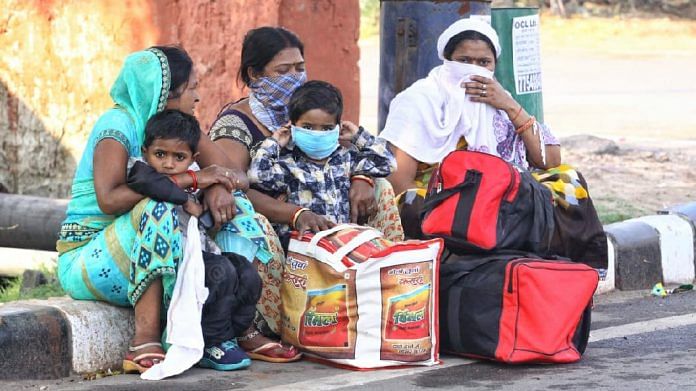The spread of coronavirus in India has flagged some administrative challenges that were never experienced during the worst floods and epidemics in the foreseeable past. Never before was there a threat of transmission by merely touching a surface harbouring the coronavirus, which has prompted the Narendra Modi government to impose a nationwide 21-day lockdown.
At an individual level, the only four preventive measures known so far are social distancing, testing, disinfection and personal hygiene. They are all dependent on individual discipline, which, when it is weak, requires an administrative plan that can plug the holes.
Also read: Modi govt, RBI, private sector, citizens: How India can be leader in fight against Covid-19
From inter- to intra-state movements
Curtailment of inter-state movement and daily commutes has resulted in chaos at some borders. Migrant workers are making a bee-line for their villages, only to face local resistance from the community because of possible infection. These are new challenges — both for administering the borders and for quarantining returning migrants. Perhaps an inter-state authority is needed to manage the borders and cross-state movement across contiguous districts.
Serious responses need serious leadership. In the recent past, we have seen chief ministers, ministers and even the senior most district officials merrily participating in public events, including large weddings and religious congregations. Sunday’s Janata curfew was implemented in an exemplary manner across India. And then quite unexpectedly, it was thrown to the winds once the 5 pm interlude became licence to celebrate.
The challenge lies in getting everyone, howsoever powerful, to listen and follow the rules. And if defied, when to use the law, persuasion, ingenuity or naming and shaming, which has to be a call taken by local officials. This presents a huge challenge for relatively junior officers unaccustomed to exercising direct authority. They will need support and encouragement.
Also read: India doesn’t want taali-thali charity from billionaires, it wants Socialist state to act
Managing cases, using resources
Testing and case management will be another trial of administrative preparedness. Normally 70 per cent of all health-related services are provided by the private sector but coronavirus is vastly different. Private hospitals and nursing homes may refuse admission to COVID-19 cases, which needs advance planning. The paucity of doctors and nurses in the public sector will be felt acutely now — perhaps the biggest challenge that lies ahead — if people eventually need hospitalisation to stay alive.
Designated quarantine and treatment centres, whether these be schools or empty buildings, and equipped with ICU facilities would need to be established urgently and kept in readiness without loss of time. A district-wise roster of doctors and nurses would need to be drawn up in advance, with abundant provisioning for personal protection equipment. Case management and treatment drills need to be understood and implemented by following check lists.
District officers will need not just authority but also the resources and flexibility to take on-the-spot administrative and financial decisions to save lives. This must be given in writing straight away so that they can plan and manage things. Intra-state districts — those within the same state — are vastly different. For instance, Maharashtra’s Ratnagiri and Gadchiroli. As for inter-state, what works in the southern states always takes much longer to implement in Uttar Pradesh, Bihar, Rajasthan, Odisha, Chhattisgarh, Jharkhand, Uttarakhand, and Madhya Pradesh. This needs a careful watch and hand-holding if things are to fall into place.
In a country with 728 districts and about 650,000 villages, accounting for 67 per cent of the rural population and over 475 urban agglomerations home to 33 per cent urban India, it would be foolhardy to assume that mere issue of orders will prevent coronavirus from spreading.
There is an urgent need for sub-national administrative and health machineries to begin using informers to identify suspect cases, start community testing and enforce isolation and quarantining. Public anxiety will escalate with each new confirmed case within a congested community and sudden death cases will spread panic. Managing a backlash, howsoever unfair, must be anticipated starting now.
Also read: Plague of 1896 redefined sedition. Coronavirus mustn’t bring in laws that outlive crisis
CMs to DMs, India needs everyone
Chief ministers apart, at an operational and oversight level, the state chief secretaries and health secretaries are responsible for co-ordination, issuing instructions, collecting incidence data and assigning flexi-funds for spot purchase.
At the district level, the district magistrates (DMs) and the chief medical & health officers (CMHOs) supported by the superintendents of police are responsible for the implementation of almost everything. On them depends successful containment but also failure. Daily reporting of incidence, focal points and operational practices would need constant oversight by the state and even the Union health ministry.
At the city level, the municipal commissioners are in charge. Written clarity about their responsibilities is needed, leaving no scope for stonewalling and the usual tug-of-war between public health and municipal staff while containing even simple outbreaks.
India is fortunate to have a functioning Integrated Disease Surveillance Programme (launched in 2004 and used in SARS 2010) and easily available geographic information system (GIS) maps right up to the block and village levels. But the states need to access this data to undertake forward planning as though this were war time.
Nothing can be considered too big for the containment of coronavirus.
Shailaja Chandra is a retired civil servant and former secretary in the health ministry. Views are personal.






